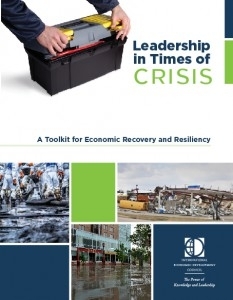Jul302014
Posted at 2:30 PM
Everyone sees the destruction caused by a natural disaster –the loss of life and property make headlines for weeks. But natural disasters can have lasting effects that don’t garner as much media attention. Beyond property and infrastructure costs, disasters impact the health of the business community. According to the Small Business Administration, as much as 25 percent of small businesses do not reopen after major disasters. Communities need to be prepared for all of the effects of a natural disaster, and there is a new tool available to help them be more resilient.
The International Economic Development Council (IEDC) recently launched "Leadership in Times of Crisis: A Toolkit for Economic Recovery and Resiliency" – a guide to help communities recover their economy after a disaster. The toolkit was funded in part by an Economic Development Administration (EDA) grant and is available for free download at www.RestoreYourEconomy.org. It includes practical resources, proven how-to's, real world case examples, checklists and best practices to implement recovery programs following any type of disaster and to make preparations in order to be more resilient after potential future events.
"Leadership in Times of Crisis" provides strategies and tactics for community leaders to focus on for economic recovery and preserving jobs, incorporating useful information for convening private and public stakeholders to identify key economic recovery strategies, tips on how to navigate federal resources for response and recovery, and implementation of recovery initiatives.
A wide range of public and private sector officials that provide support to businesses and industries in the economic recovery process can benefit from using the toolkit, including economic development organizations (EDOs), chambers of commerce, business leaders, small business development centers (SBDC), community colleges and business schools, and community development financing institutions (CDFIs), among other organizations.
The Toolkit's 11 chapters cover:
• Disaster preparation for organizations, businesses and communities;
• Small business assistance;
• Business retention and expansion;
• Strategic planning for economic recovery;
• Economic impact studies;
• Economic diversification; and neighborhood redevelopment.
• Case examples, including Hurricanes Katrina, Ike, and Sandy, tornadoes in Joplin, MO and Greensburg, KS, Cedar Rapids flooding, and the Northridge Earthquake;
• Checklists, forms, sample plans, and resource contacts.
Floods, tornadoes, hurricanes, and earthquakes happen –sometimes without warning. We cannot stop disasters from happening, but we can work to be more prepared when they do. EDA and IEDC hope that this toolkit can be to businesses what bottled water, a first aid kit, flashlights and batteries are to citizens: a vital tool for survival when disaster strikes.




